Trip leader Ronald cheerfully refers to our daily
game-viewing drives as “going fishing”, a reference to the uncertain nature of
what you would “catch.” (If he were a
movie fan he probably would have said that a safari is like a box of
chocolates.) Today was our first full
day of fishing in the Serengeti. The
typical pattern is to rise early when it’s cooler, bounce along narrow, rutted,
and barely passable dirt paths looking for the Big Five and other assorted
lesser creatures for four or so hours, and then return to the camp for lunch and a
siesta (or hand laundry) until about 4 p.m. when we repeat the process in the
“cool” of the afternoon. However, cool
is a very relative term here, and it’s almost always suffocatingly hot to us
Alaskans regardless of time of day. It
is a dry heat (which dries our laundry very quickly), but still quite hot. It is noticeably cooler by 5 p.m.,
and certainly
more animals are visible again. Then we
return to camp for happy hour around a somewhat anemic campfire followed by
another huge meal and early to bed because after all, there’s not much to do
but listen to animal sounds off in the distance and you’re going to get up
early again the next morning.
So, on this first day we started out by following a flock of
blue helmeted guinea fowl down the path for quite some distance. Like moose on Alaska Railroad tracks or a
family of ducks on a river, the birds just didn’t want to get off into the high
grass, but one by one they fell
away until just the lone leader remained,
apparently thinking his entire flock was still behind him. He finally squawked off the road and we can
pick up the pace. Next we ran across a
couple of cheetah adolescents and their mother crossing the road right in front
of and behind our jeep. Apparently
cheetah mothers are known to try to lose their cubs by about this age, so this
one may have been trying to get away from the cubs on the other side of the
road! More impalas and giraffes
followed,
along with all sorts of birds (bustards, storks, vultures) and more
cheetahs, and then we found a pod of hippos, chilling and splashing water on
themselves in a pond.
Mid morning called for a stop at a small park museum, where
we rendezvous with the six members of our group who had gotten up even earlier
than the rest of us to leave for a 5 a.m. sunrise balloon flight skimming low over
the Serengeti. It sounded very nice,
including a champagne breakfast, but priced at $485 seemed a little too spendy
for us, particularly as
Alaskans who are pretty familiar with skimming low over
the terrain (and just below the clouds).
Plus, 6 a.m. was quite early enough to start the day. The museum gave a good overview of the park,
both its early pre-protected history, how it became the sanctuary it is today,
with outdoor examples of the various kinds of habitat.
Back on the track (bush shorthand for bumpy, rutty and,
after last night’s downpour, muddy roads) after the break, we find more hippos
and a crocodile sharing the same wide spot in a river. The croc never moved while we watched, and
some of our group had a hard time believing he was not just a log. This was the only crocodile we saw on the
trip. Apparently
you have to be much
farther north to catch the spectacle of the crocodiles grabbing wildebeest as
they cross rivers. Just before the lunch
break, we spotted a leopard with cub in a tree near the track. Another member of the Big Five checked off on
our list. Leopards are quite shy and it
can be difficult to find them, we are told.
Once again, our “fishing” guides serve us well.
After lunch back at camp (and the laundry hour), we head out
again for more elephants, giraffe, Cape buffalo, warthogs, and black face
velvet monkeys. With the savanna
literally
teeming with all these animals, every potential photo seems better
than the ones already taken, so we snap more and more and thank modern technology
for the digital zoom camera. Lots of
birds seem to show up this time of day, including white crown shrikes, slate
colored bulbul (who make several different calls including one that sound just
like, yes, “boo boo boo”), yellow neck spurfowl, hoopoe, gray heron, Fischer’s
lovebirds (which are bright like parrots), and greater and lesser flamingo
(stretched in a huge line across salty Lake Magadi).
However, the biggest find of the afternoon
was a dozing lion on top of a large rock called the “sounding rock”, which has
some hollows that magnify the sound when a small rock is banged against
it. On a good day, visitors are
encouraged to actually walk up to the top of this rock and bash it, but no one
volunteers today. This particular side
of the Serengeti, the southeastern quadrant, is dotted with the large rocks,
called kopjes, which are granite
outcroppings around which the soil has eroded
away over time. Lions love to loll on
them and survey their surroundings, and this is not the last time we’ll see
this situation. Our last highlight of the day, just before reaching camp,
was a family (a troop) of baboons who scramble all around us and across the
track, noisy and quarrelsome. Quite a
difference from the lone baboon earlier today who turned his back and
studiously ignored us.

 Serengeti National Park, Tanzania
Serengeti National Park, Tanzania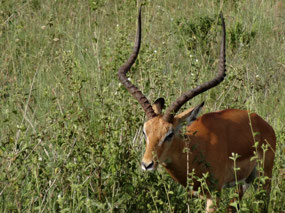
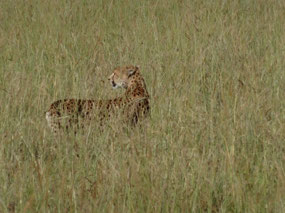
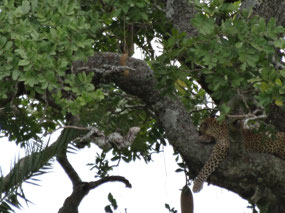
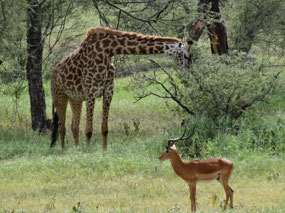
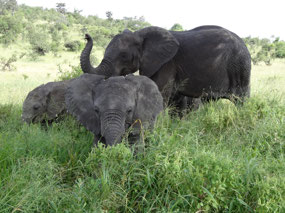
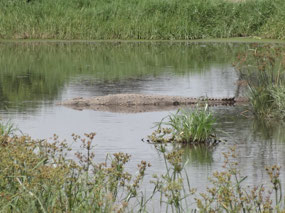
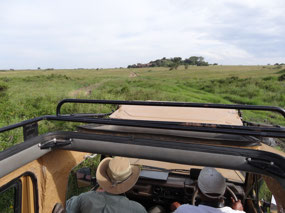
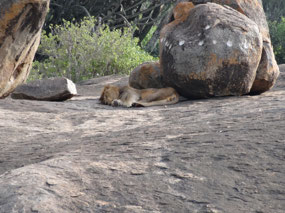
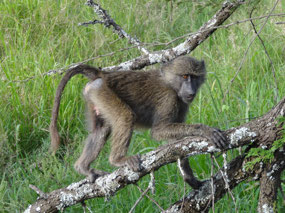




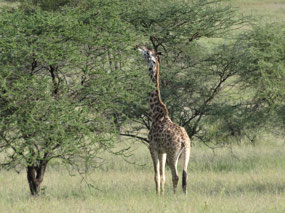
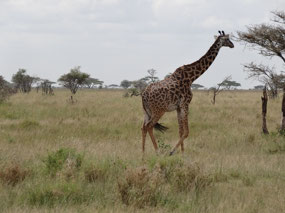
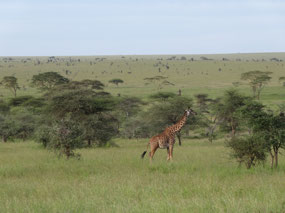

2025-05-23